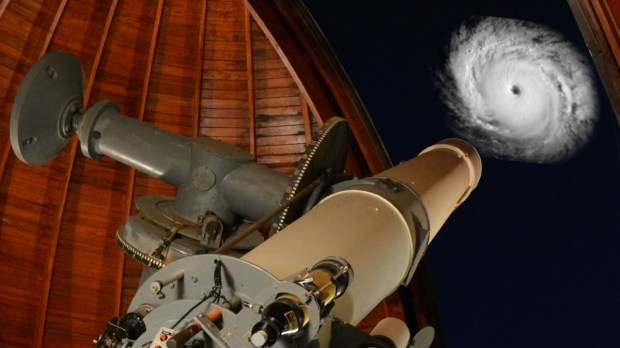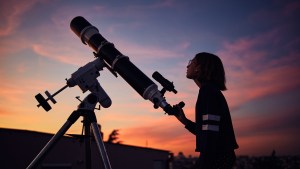The month of June ushered in both the Atlantic hurricane season in the northern hemisphere and some new research about who first envisioned the physics of hurricanes. Who did that? Scientists with the Society of Jesus (the Jesuits), that’s who.
A hurricane’s rotation comes from something called the Coriolis Effect. That effect is caused by Earth’s spherical shape and its rotation. Earth’s rotation creates almost no motion at all at the north and south poles. It creates rapid motion at the equator, however, because points there travel around Earth’s full circumference in just 24 hours. The fact that the speed of Earth’s surface varies with latitude means that air that rushes toward a strong atmospheric low pressure zone will be deflected into a circular path around that “low,” setting up the winds that circle around the low-pressure “eye” of a hurricane.
Gaspard-Gustave de Coriolis worked out the detailed mathematics of this hurricane-causing effect in the early 19th century. Meteorologists have long considered George Hadley to be the first person to conceive of the effect generally, in a paper he wrote in 1735. But in fact, Jesuit scientists were working out the effect a full century before even Hadley.
Br. Guy Consolmagno (of the Society of Jesus, and Director of the Vatican’s astronomical observatory) and I recently published research about their work in The Catholic Historical Review, a century-old scholarly journal published by the Catholic University of America Press.
In the 17th century, whether or not the Earth rotates was an important question. Nicolaus Copernicus said it did. Such rotation was required by his theory that the Earth orbits the sun along with Venus, Mars, etc.
However, common sense said that Earth stands still. After all, if you live near the equator, Earth’s rotation must be hurtling you along at 1,000 mph, or 1,600 kph, right now. Even if you live at more northerly latitudes, you must still be moving faster than the fastest sports cars, and far faster than any vehicle in the 17th century. Yet what do you feel? Nothing.
The Bible also spoke of the Earth as standing still. The Psalmist said that God set the Earth on a foundation, so “it shall not be moved for ever and ever.” (This is Psalm 103:5 in the Douay-Rheims English translation, published at the turn of the 17th century, Psalm 104:5 in modern translations.)
Bible doesn’t have to be literal, say the saints
Copernicans argued that we cannot detect Earth’s motion because everything moves together. Meanwhile, people since at least the time of St. Augustine in the fourth century A.D. understood that the Bible need not always be interpreted literally. Augustine said that even though Genesis 1:16 calls the sun and moon the “two great lights” in the sky, the moon need not be truly larger than other heavenly lights. Indeed, even in Augustine’s time astronomers knew that stars were larger than the moon. St. Thomas Aquinas took a similar view in the 13th century. Genesis 1:16 spoke to appearances, he said: “though the stars be of greater bulk than the moon,” he wrote in the Summa Theologica, “as far as the senses are concerned, its apparent size is greater.”
This same approach could be taken regarding Earth’s rotation. Biblical verses that speak of Earth as unmoving could be interpreted as describing things as they appear to us. But the rule was that you did not do this lightly. In 1612, Galileo was discovering many new things with his telescopes and advocating for Copernicus’ ideas. He asked the opinion of Cardinal Carlo Conti about Scripture and Copernicus. Conti replied that a Copernicus supporter could deal with the Bible’s words indicating that Earth is at rest by saying that Scripture “speaks in conformity with the common mode of the average person.” However, he added, “this mode of interpreting must not be admitted without great necessity.”
Cardinal Robert Bellarmine told Galileo pretty much the same thing. The words of Scripture matter, and therefore you don’t abandon their plain, literal sense unless truly necessary. That is, unless there is no doubt that the plain sense does not hold up, as with the “great lights” in Genesis (and as with other places in the Bible, such as Malachi 1:3, where God, who is love, comments, “I hated Esau [Jacob’s brother]”).
Was it necessary, then, to abandon the plain sense of the Bible’s description of a fixed Earth and a moving sun? That’s a science question. For all that has been said regarding science versus religion in the “Copernican Revolution,” ultimately the question was just a matter of science.
Jesuits tackle the science
The science of Earth’s rotation is what Jesuits like Fr. Christoph Scheiner, Fr. Giovanni Battista Riccioli, and Fr. Claude François Milliet Dechales were thinking about in the 17th century. They considered what would happen if Earth rotated. They realized that, if it did, everything would not, in fact, be moving together. They understood that the equator would be moving faster than the poles. Scheiner, Riccioli and Dechales each added a bit to the picture, publishing their ideas in different books (Scheiner in 1614, Riccioli in 1651, Dechales in 1674). They did not think about air and winds flowing in different directions, but about projectiles like cannon balls launched in different directions.
They figured out the Coriolis Effect. Interestingly, their view was that this effect should exist if Earth rotates. But, they thought that it in fact does not exist. Its absence, they said, was a scientific argument against Copericus and in favor of an unmoving Earth. (They embraced a model of the universe developed by the astronomer Tycho Brahe, which both agreed with new telescopic discoveries, such as those made by Galileo, and featured an unmoving Earth.) It happens to be surprisingly hard to detect the Coriolis Effect in projectiles. Even modern textbooks, used by science students today, tend to exaggerate the influence that the effect has on projectiles (click here for more, from Physics Today, on what Br. Guy and I discovered on that).
No institutional conspiracy after all
Why does this matter today?
It matters because many people today think of science in terms of a mythical conflict between religion and science, and in terms of conspiracies. Again and again you can read about how in the Copernican Revolution, “The Church” supposedly rejected scientific discoveries, or opposed science generally; Church officials supposedly refused to look through telescopes, and so on. It was, the story goes, a vast institutional conspiracy to suppress The Truth, all because a new idea from science contradicted a plain reading of the Bible. That’s all bogus. If we do not want people to turn to conspiracy theories involving institutions hiding scientific truth today (regarding vaccines, UFOs, climate change, etc.), we need to stop saying that exactly that sort of thing happened at the very beginning of modern science. The fact is, Jesuit scientists at the time were thinking scientifically about Earth’s motion, in ways that turned out to be well ahead of their times.
It also matters because it illustrates the importance of remembering history. At the turn of the 20th century another Jesuit investigated the Coriolis Effect. His name was Fr. Johann Georg Hagen, and he was the first Jesuit to be Director of the Vatican Observatory. He developed new experiments and built new apparatuses to study the effect. He did this right within the Vatican itself. He published his work in a book. He presented it to other scientists. But he never made any mention of the work of his Jesuit forebears, Frs. Scheiner, Riccioli and Dechales. Their work had been forgotten, even by Jesuit scientists. That forgetfulness made space for the myths.
So when you hear about hurricanes and their winds, think about Frs. Scheiner, Riccioli, and Dechales. They were thinking about the physics behind hurricanes four hundred years ago.
—————————
Interested readers can find “Spin off: The Surprising History of the Coriolis Effect and the Jesuits Who Investigated It” by Christopher M. Graney and Guy Consolmagno, S.J. in The Catholic Historical Review, Volume 109, Number 2, Spring 2023, pages 302-320. The Catholic Historical Review is available on-line through Project Muse and through many libraries via EBSCO and ProQuest full-text databases. A version of the Jesuit-Coriolis story that is adapted for a more general audience will appear in Graney and Consolmagno’s forthcoming book from Paulist Press, When Science Goes Wrong: The Desire and Search for Truth, to be released this fall.



